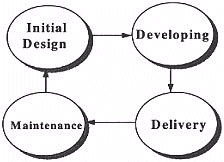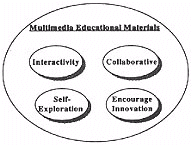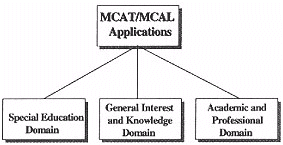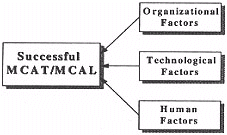
 |
Multimedia has become a focus of research in educational delivery, learning and its assessment Many advantages and disadvantages have been pointed out. As such, more research needs to be done to identify the extent to which the structuring of multimedia in education delivery at various levels has incorporated the theories of education from the standpoint of curriculum and learning. Because 'overestimating the speed of diffusion of an innovation and underestimating its eventual consequences and side effects' are the most common mistakes made in evaluating the effectiveness of new technologies in education. It 'may be just as likely to drive education in unwanted as in desired directions'. This paper looks at how multimedia is used in education including survey of the state of art in use of multimedia as an educational tool, discussing how the materials are used in teaching and how human learners are treated with the underlying curriculum and learning theories and assumptions contained in them about the nature of knowledge, instruction and learning. The paper also discusses the advantages, requirements and the limiting factors to be considered for creation of multimedia applications in education.
Multimedia computer based training and learning including hypermedia technology has been an area of research for the educational experts. There are different courseware designed for teaching and learning and they have been proven effective in accelerating the process of learning. The conventional way of teaching and learning is empowered with the advent of multimedia technology. Multimedia technology also enriches the content of computer based education by providing media rich study materials for students. Further more, it changes the way that the end users are interacting with computer systems. Experiences of the researchers in evaluating the quality of learning from hypermedia documents has been highly positive and it has been established that some of the positive attitude is due to the novelty of the medium (Brown, 1995).
Multimedia computer mediated instruction can offset the potential decline in the quality of education brought about by rising student numbers without commensurate increases in teaching staff. Ibis was one of the central tenets of the UK Governments' Teaching and Learning Technology program (TLTP) initiative which was sponsored by the British Higher education Funding Council (Ruggles, 1995).
This paper looks at how multimedia is used in education including survey of the state of art in use of multimedia as an educational tool, discussing how the materials are used in teaching and how human learners are treated with the underlying curriculum and learning theories and assumptions contained in them about the nature of knowledge, instruction and learning. The paper also discusses the advantages, requirements and the limiting factors to be considered for creation of multimedia applications in education.
This might be adequate in some context, but might not be true in another. There are situations when knowledge and concepts cannot be expressed by words alone and hence only text based environment is inadequate for effective learning. The process of knowledge acquisition can be more effective if the learners can experience an event through computer simulation incorporating multimedia in a seamless way. Multimedia technology empowers the teaching and learning process. It allows educators to include multiple media into the teaching materials and makes the study more interesting or even more motivated. It improves the quality of education as well as the interaction between teachers and the students. Further more, it encourages and enhances peer learning as well as individual creativity and innovation.
In the conventional education framework, as shown in Figure 1, consists of two main entities: Educator and Learner. The communication between these two entities is basically a one way process.

Figure 1: The conventional education framework
Educator normally plays the role as information provider who delivers conceptual knowledge to the learners. Learner is the receiver of these knowledge, but how and how much they could really absorb is merely answered. There is no mechanism to effectively aid the learner to process and comprehend these abundant information and knowledge. The effectiveness of the education in this setting is questionable. Multimedia has the capability to empower the constructivist approach for learning through collaborations, self explorations, simulations, models and creating media rich study materials. Pictures, video and sounds are incorporated in a structured manner facilitating the learning of new knowledge much more effectively. The interactive nature of multimedia can also provide the learners more flexibility to adapt to their own learning strategies. It enables both the educators and learners to work together in an informal setting. The role of educators and learners are extended. Figure 2. demonstrates our view of multimedia courseware as a communication channel between teachers and students which re-engages and accelerates the education process.

Figure 2: Multimedia re-engages and accelerates the education process
Computer based multimedia courseware has rewired the education process by giving the students opportunity to demonstrate their understanding and idea. With multimedia computer tools, such as media editors, the learners can engage in more creative work encouraging innovations. The interactive visual representations enable students to communicate their ideas more effectively in an informative manner. The educators can learn the instructional needs of intending learners and thus the new understanding of a subject might also be discovered. The MCAT/MCAL applications can be developed and delivered on the CD-ROM or online through the Internet. Learners can have access to them regardless of the time and space.

Figure 3: The process of creating MCAT/MCAL tool
The initial design stage involves the gathering of ideas, requirement, identification all necessary elements of course materials, and feasibility studies, which states the suitability of the product to the existing teaching and learning methods. In the developing stage, creators of the product proceed with all necessary resources. At the delivery stage, we are concern about how the MCAT/MCALs material can be delivered more cost effectively (such approach might be through Internet or CD-ROM or a combination of both). The fourth stage, is an on-going process of maintenance. In this process, the users and developers will be continuously updating the content and improving the functionality of the MCAT/MCALs system. The users play an important role in all the four stages of CAT/MCALs creation.
We have identified four main characteristics to be incorporated in the multimedia educational materials, namely: Interactivity, Collaboration, Self exploration and Encourage Innovation. as shown in Figure 4.

Figure 4: Characteristics of multimedia educational materials
Interactivity: MCAT/MCAL tools shall not just "deliver" information to the learners, but also enable interactive learning. Educators and learners should be capable of getting immediate responses of their actions during the process of knowledge seeking and exploration.
Collaboration: Multimedia education tool shall provide environment for collaboration among the intended users, both learners and educators. Simultaneous access to a multimedia resources (ie. video clip, audio segment, picture, etc) by multiple users is essential for collaborated learning and teaching.
Self Exploration: In general, different people have different capacities of sense making. This is due to our different sense making training. Thus when people process the same piece of information, they will apply their unique way of sense making methods. One of the recommended learning methods is self exploration. Through self exploration of knowledge, new understandings of a subject can be constructed more effectively. This has specific benefits to students who find the conventional way of education insufficient for their learning. The introduction of multimedia technology as an instructional tool allows the educators to "deliver" knowledge more dynamically through media rich course materials, and hence encourages the students to learn more effectively by matching their diverse learning patterns and instructional needs.
Encourage Innovation: The MCAT/MCALs should allow learners to express their understanding to a specific subject of knowledge innovatively and dynamically. This also encourages the learners to participate in the learning process positively while they are gaining more confidence in manipulating course materials and are able to create something that their peers might not be able to do, thus allowing other learners and educators to explore the knowledge of a domain in many dimensions.
There have been tremendous amount of MCAT/MCAL applications targeting diversity of domains such as schools, family, professional training and employees job training. Some of these applications from our survey and a brief overview of their features are discussed in the subsequent sections.
Generally speaking, these MCAT/MCAL applications can be categorised into the three major domains as shown in Figure 5.

Figure 5: The application domains of MCAT/MCAL
The Conroy Education Center (Holzberg and Carol, 1994) is a special education school in Pittsburgh, PA, where multimedia technologies are adopted to complement the education of adolescents with developmental delays to protect themselves against victimisation. The school's laboratory is divided into three areas to focus on academic skill building, telecommunications, and anti-victimisation training. A potential victimisation scenario (ie. teenagers are involved in the preparation of a party) created by a multimedia simulation software package on five interactive video stations is used to assist anti-victimisation training.
In the area of scientific knowledge learning, 'the Science Sleuths CD-ROM For Kids' (Anis and Nick, 1994) allows small children to learn science knowledge through solving real life science mysteries by applying research skills and scientific principles used by actual scientists and engineers. The question and answer schema encourages the learners to articulate scientific theories. This package consists of a unique set of stimulated, interactive experiments and tests, along with a library of multimedia resources. Learners can choose from a list of science mysteries to solve. The "Sleuth Headquarters" is a virtual reality science laboratory where the learners can simulate experiments with multimedia resources and more than a dozen interactive scientific tools, such as a Bunsen burner, microscope, and Geiger counter. Live video clips and interviews of witnesses and experts in the scientific fields are also utilised to complement the learning process. An interactive "notebook" allows the learners to record their findings and hypotheses and a final report or "case" is produced and printed out. The Master Sleuth determines if they have solved the mystery and tests their knowledge of key scientific concepts.
The system empowers the students' learning process by allowing them to communicate with the teachers and peers electronically through HTML forms. The multimedia courseware developed by Biodiversity Consortium [HREF 2] for the first year undergraduates in biology science consists of two major components: the teaching materials (UNIT) and the courseware delivery engine (the Scholar's Desktop) which is an interactive multimedia interface effectively assisting the learners in accessing the study materials. Video, sound and pictures are used to enrich the content of the system which makes the learning more interesting. Another application the CAL/Multimedia Projects in Electronic Engineering is an ongoing multimedia CAT/CAL project in University of Wollongong [HREF 3]. The system consists of three main modules: Computer Aided Tutorial (CAT), Computer Aided Laboratory Experiment (MCALE) and Computer Aided Self Learning (CASL). Learners and educators can exchange information and give feedback through the interactive multimedia environment. Multimedia simulation based Power System Education is also a MCAT/MCAL project in University of Wollongong [HREF 4] which is an computer based teaching/learning methods to assist learners to fit into the highly advance power systems industry through simulation of problem solving and experiments. Learners and teachers can exchange ideas and discuss problems in an interactive multimedia environment. The Office Simulator [HREF 5], a multimedia office training system provides simulated business training program to the users. The computer simulation with sound and pictures bring the learners to an interactive virtual office environment where they can explore the objects by clicking on it. Instructions and messages am delivered to the learners in multiple media forms.
Coiro et al (1993) described an experimental multimedia CAT/CAL for distance learning, implementing on digital telecommunications facilities. This system is designed for distance learning purposes and supports various kinds of sessions. It allows the users to exchange video, voice and data simultaneously. There are two types of channel connections setup to support the distribution of multimedia data, the isochronous or asynchronous channels. The formal one enables the distribution of real time audio and video with the required quality, whereas the later one or a combination of both support still images (with various resolution), animation, and graphics. The implementation has two specially equipped classrooms currently setup in two separate towns. These classrooms are facilitated with cameras, video projectors, video codecs, multiplexers and a specialised still image management system. For primary school education, Smith and Maureen (1995) described an Internet based multimedia CAT/CAL system for the sixth grade geography students at the Minnetonka Middle School. The students study the geography, culture, climate, ecology, and biology of various regions through multimedia electronic expeditions on the Internet. The multimedia curriculum in history, art, science, ecology, math, biology, and anthropology enrich the students' exploration and study. The system also provides other facilities, such as electronic mail, forum discussions, FTP for downloaded photos, graphics, and real time question and answer sessions between students and domain experts from different areas of scientific research.
The Students and Teachers Integrated Learning Environment (The STILE) is a resource base approach using hypermedia to provide greater opportunities for independent and flexible modes of learning and mechanism for both educators and learners to discover and access relevant resources as they require them, together with facilities that enable users readily to use and re-use existing materials of their own in a way that seems natural to them (Ruggles, 1995). Thus it is considered as a set of tools and services and a continually developing resource base rather than a closed and finished product.

Figure 6: Factors contributed to successful MCAT/MCAL
Brown, P. J. (1995). Creating educational hyperdocuments: Can it be economic? Innovations in Education and Training International, 32(3), August, 202-208.
Coiro, S. et al (1993). Design and experimental monitoring of an ISDN based multimedia distance learning service. Proceedings of the 3rd Teleteaching Conference, TeleTeaching 93 IFIP Transactions A: Computer Science and Technology, n A-29, p157-166, Norway.
Holzberg and Carol (1994). Technology in special education (using technology to motivate, teach, and empower children with disabilities). Technology & Learning, Peter Li Inc. April, 14 (7), p18(4).
Ruggles, C., Underwood, J. and Walker, D. (1995). STILE: A hypermedia approach to the provision of a flexible, interdisciplinary resource base for teaching and learning. Innovations in Education and Training International, 32(3), August, p 209-219.
Smith and Maureen (1995). The new "Trekkie:" Students travel from the Arctic to Brazil over wire (online expeditions). Electronic Learning, Feb, 14(5), p26(3), Scholastic Inc.
Solomon and Martin (1994). What's wrong with multimedia in higher education? T H E Journal (Technological Horizons In Education), 21(7), p81(3).
Staufer, M. (1992). Technological change and older employees: Implications for introduction and training, Behavior and Information Technology, 11(1), 46-52.
T H E Journal - Technological Horizons In Education (May 1995), 22(10), pS1 (64).
| Authors: Syed M Rahman, Kei Nam Tsoi Gippsland School of Computing and Information Technology Email: (Syed Rahman, Keinamt)@fcit.monash.edu.au Graham Dettrick Gippsland School of Education Email: Graham@ccs4.cc.monash.edu.au Monash University, Churchill, Victoria 3842, Australia Please cite as: Rahman, S. M., Tsoi, K. N. and Dettrick, G. (1996). Multimedia as an educational tool: An overview and the future. In C. McBeath and R. Atkinson (Eds), Proceedings of the Third International Interactive Multimedia Symposium, 328-335. Perth, Western Australia, 21-25 January. Promaco Conventions. http://www.aset.org.au/confs/iims/1996/ry/rahman1.html |